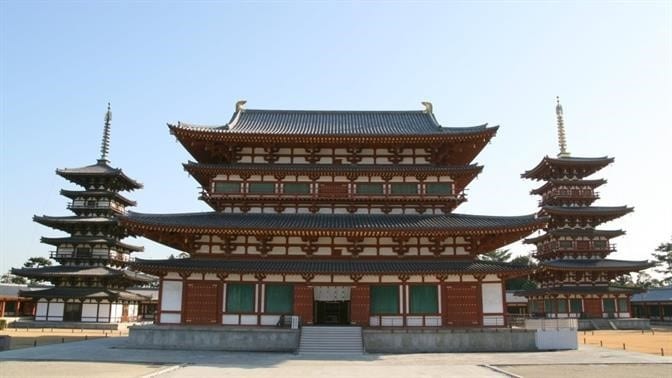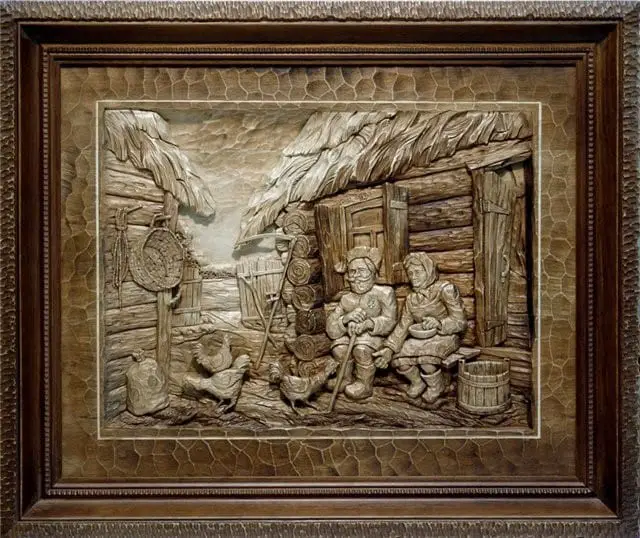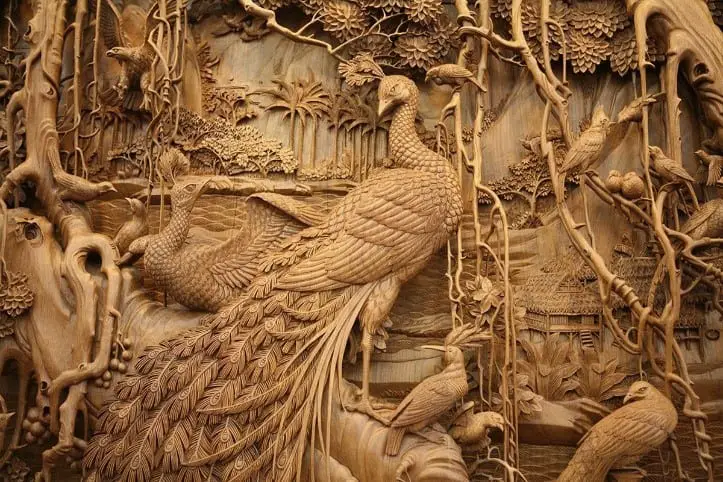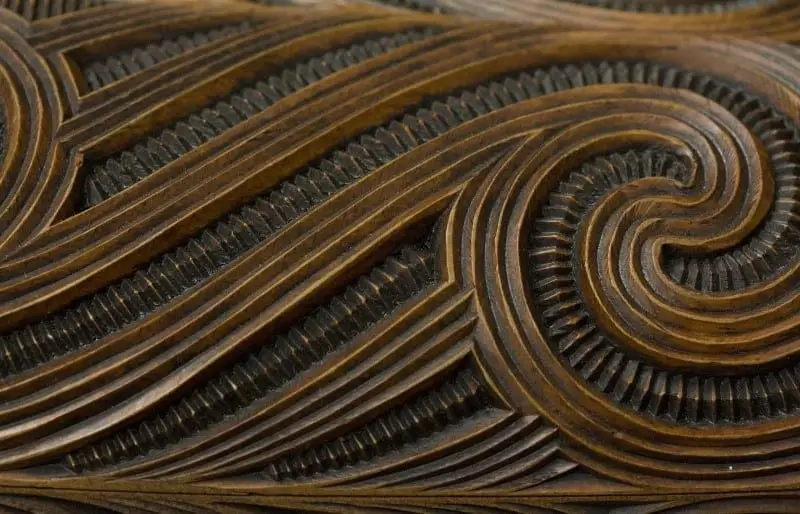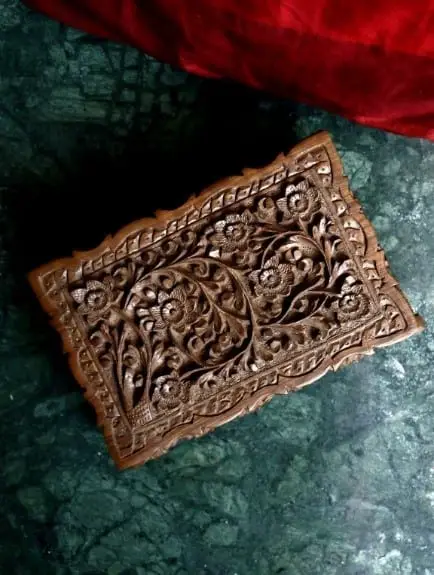
At the very mention of Hawaii, most of us picture themselves roaming a golden coastline of sandy beaches and tranquil waters, surrounded by the unique beauty of mysterious forests and steep cliffs that slowly merge with the skyline as far as one’s sight can reach.
From delicious cocktails through tropical flowers, Hawaii Island allures the imagination of those who are eager to get a taste of exoticness. What’s more, Hawaii also carries ancient traditions in the art of handicrafts. Thus, wood carvings have steadily become a trademark of the country.
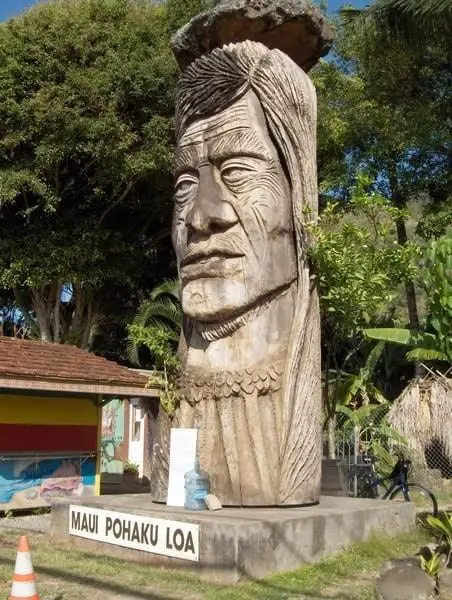
A magnificent example of wood carving in Hawaii – Maui Pohaku Loa is the last of the “Whispering Giants” series that was completed in 1988 from a 7’ wide Douglas fir tree – Image Source
But when did the art of wood carving originate in Hawaii? What is the legacy that master Hawaiian wood carvers leave behind by preserving the traditions of their ingenious crafts?
Below, we will go on a journey to discovering Hawaii’s carvings secrets and we will dig deeper into the enchanting mysteries surrounding the core beliefs of the natives.
Brief Introduction to Pacific Art: A Fusion of Cultural Exchange & Spirituality
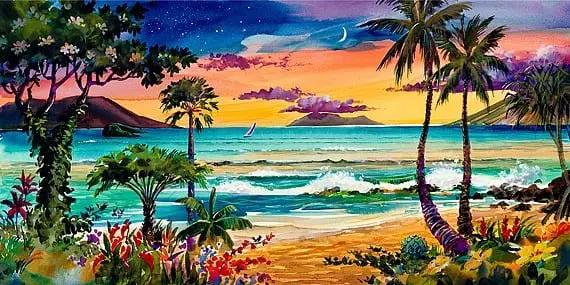
Wailea Moon by Jim Kingwell – Contemporary Hawaiian art – Image Source
For a start, it’s essential that we get to know more about the wide area that Pacific Art actually covers.
In short, Pacific Art encompasses New Guinea (the second largest island in the world), Australia, New Zealand, as well as several other large islands in the area. Nonetheless, the term Pacific Art covers all the small islands that are scattered across the Pacific and generally located between South America and New Guinea. Of course, one of these islands is none other but Hawaii.
It is often the case that Pacific Art is also referred to as Oceanic Art. In fact, both ethnologists and anthropologists typically divide Pacific Art (or Oceanic Art) into 3 separate zones – Polynesia, Melanesia, and Micronesia.

That separation is also very useful when it comes to compiling the style of the different art trends across the Pacific into different categories. These categories are shaped based on the influence of various island cultures, creating a unique type of cultural exchange.
And indeed, even though we are used to referring to cultural exchange as a modern-day term to describe the collaboration between different cultures, this type of exchange is evident throughout the course of history from ancient times.
But more importantly, cultural exchange has played a key role when it comes to Pacific Islands Art.
To illustrate this, the Oceanic artifacts consist of various carved figures and masks that were further decorated with the use of a chisel or inlays. The repetitive patterns typical for the Oceanic art were further enriched by the Melanesians who came up with the brilliant idea of adding color to bring a new sense of beauty into the traditional crafts.
Above all, ancient Pacific Island art was actually never seen as “art” by the natives, at least not to the same extent we see it today in Western society.
Instead, sculpture, painting, and wood carving were a natural part of everyday life on the islands. Moreover, all these various crafts served a spiritual purpose.
Last but not least, the ancestors of Pacific Island crafts did not use art as a means to express their ideas on a personal level. Instead, sculpting, painting, and carving were means to convey the feelings of an entire group of people (tribe, sub-tribe or a family, for example).
Looking into the Invaluable Cultural Inheritance of Hawaiian Handicrafts

Contemporary Hawaiian featherwork combining the use of the rare Hawaiian Koa wood – Image Source
Ultimately, Hawaiian ancient art forms were highly influenced by the distinct Polynesian style. Polynesians are the first to arrive at the island of Hawaii approximately 1000 – 2000 years ago.
Interestingly, none of the ancient civilizations before the Polynesians had any relevant knowledge on the possible existence of the islands in the area. But the Polynesians had superb navigation and sailing skills.
Moreover, they knew how to read the natural language of our Planet Earth by using the stars and the birds for precise orientation.
On another note, many historians divide the art created on Hawaii into 2 major categories. The one is art created before Captain Cook’s arrival in 1778. And the second is art created after the arrival of Captain James Cook.
Then again, cultural exchange is what influenced the native art of the Hawaiians since the Westerners brought new materials that sparkled new ideas in return.
Thus, up-to-date, tourists who visit Hawaii can enjoy stunning pieces of traditional, as well as contemporary art in the form of paintings, sculptures, and carvings.
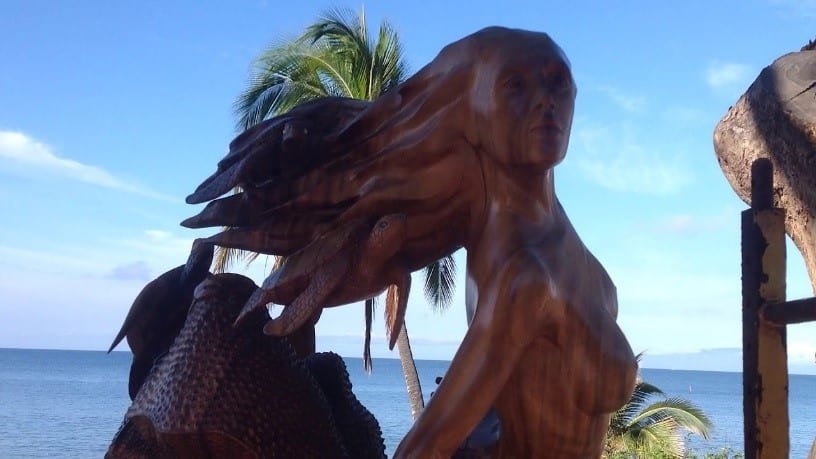
Vivid contemporary wood carving in Maui, Hawaii – Image Source
Furthermore, contemporary Hawaiian art reaches far beyond the ingenious masks, swords, and Tiki figures. Nowadays, the traditions of the ancient crafts are well-preserved but the flowing, natural creativity of the locals can be seen in modern-day wooden sculptures and carvings, too. Most of these depict natural scenes from the island life, such as animals and flowers, among others.
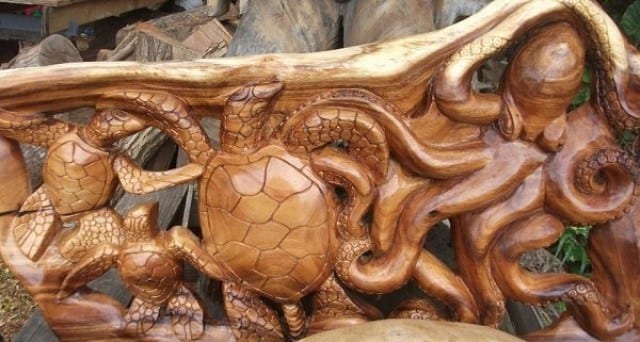
Contemporary Hawaiian wood carvings displaying sea turtles and an octopus by master woodcarver Maile Niu who learned the art of carving from his father – Victor Niu – Image Source
Nevertheless, it’s important to mention other traditional Hawaiian handicrafts such as cotton quilting, as well as the one-of-a-kind feather work. Examples of feather work can be seen in Honolulu Museum of Art but also in other museums around the globe, including University of Cambridge Museum of Archaeology and Anthropology.
Video by Harvard Art Museums – The Philosophy Chamber – Feather Work
Source: youtube.com
The Extraordinary Story of a 4th Generation Tiki Master Wood Carver: Willy “Wanderfoot”
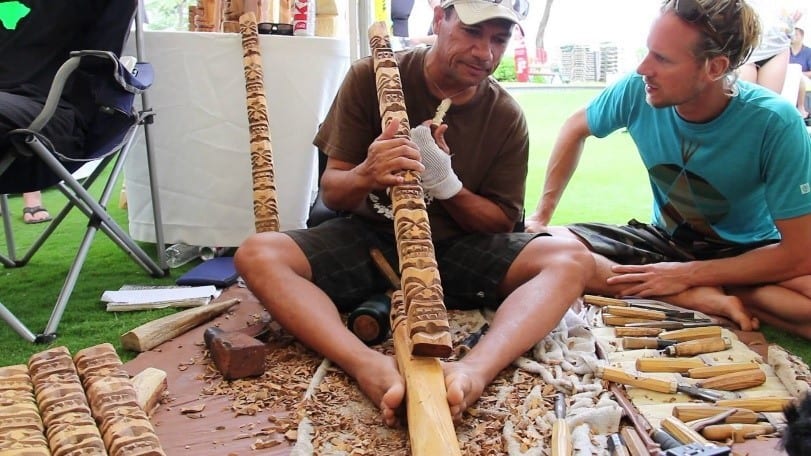
Willy in the process of creating amazing Tiki carvings in Hawaii – Image Source
Certainly, nobody knows better the secrets of Hawaiian wood carving than the master wood carvers who carry, preserve, and transmute the traditions through the centuries.
Meet Willy who is a descendant of the Polynesian art of wood carving. Without stopping his work, he talks with love about the meaning of the popular word “tiki” from a native’s point of view.
At the very mention of tiki, many of us would think of tropical cocktails, exotic masks, maybe the Hula dance, but very few will think of tiki and its real meaning – protection.
“Tiki is a protection type of art that we do here in Hawaii,” says Willy, and he also highlights that it’s not only in Hawaii but all the surrounding islands in the Pacific that the tiki represents protection to the owners.
But what’s more, each tiki carries its own, unique meaning. Each tiki has a story to tell, “it represents different things,” says Willy. He has a favorite tiki that he wears on a humble necklace. His tiki represents being strong, having power over your destiny. And he also believes that wood carving is his destiny because he acknowledges his ancestors’ legacy.
Beautifully, Willy talks about the energy that he puts into the art of carving. He says he is doing this craft because he believes carving is important for his “family, the people, the culture”, and above all – to all the people in the world.
It is thanks to people like Willy that ancient arts continue to live. And indeed, the art of Hawaiian wood carving is important to all the people in the world, too. Because acknowledging the efforts and the legacy left behind by our ancestors is the only way to preserve the memory of the humankind. We are majestically gifted with a diversity of cultures yet we cherish the same core values – we all crave for love, health, and happiness, right?

Along with protection, Tikis can also bring good luck as a blessing – Tiki Wood Carvings by the street master wood carver Moe – Image Source
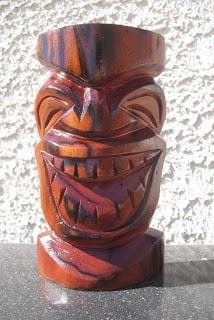
An example of the naturally beautiful and vivid colors of Hawaiian wood carvings – only a top coat of glossy lacquer is applied to this colorful Tiki carved by the street master wood carver Moe – Image Source
Video by Wanderfoot – Willy – A Wanderfoot Wood Carving Artist in Maui, Hawaii
Source: youtube.com
Must See! Hawaiian God KU Wooden Sculpture Luckily Found its Way Back Home in 2018
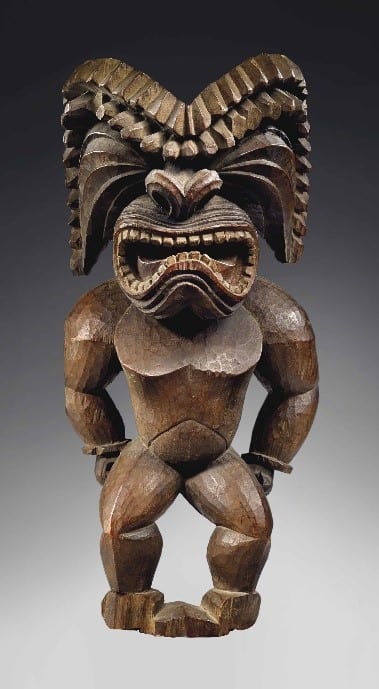
The masterfully carved Hawaiian wooden sculpture of god Ku – Image Source
According to Hawaiian beliefs, god Ku and Hina go hand in hand. More specifically, god Ku and goddess Hina represent the ancient male (kane) – female (wahine) beginning of the world. Both of these great ancestral gods are intricately connected to the generations of humankind, as well as fruitfulness of the Earth.
God Ku ruled the Heavens (KU translates into “rising upwards”) while Hina ruled the Earth (Hina translates into “leaning down”).
Together, god Ku and Hina encompass the entire earth, and they also encompass the heavens from West to East.
Moreover, when the natives asked Ku and Hina for help, they believed to be able to reach out to the people who are already born as well as those who are NOT born yet – that’s how these ancient gods relate to the generations of mankind.
Interestingly, these core beliefs highlight the unique way Hawaiians perceive the world – as a Whole where the power of ancestors can travel and transfer through the invisible realms.
God Ku is also known as the god of War who became one of the primary gods in Hawaii in approximately 750-1250 A.D.
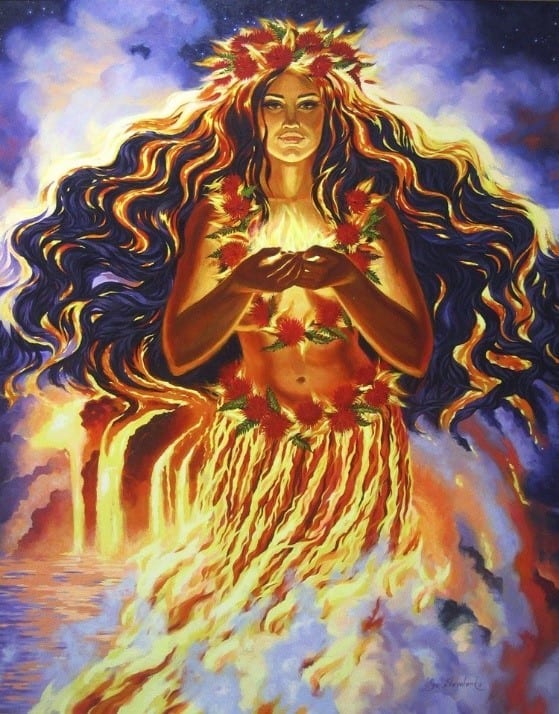
According to Hawaiian mythology goddess Pele is the ruler of winds, lightning, fire, and volcanoes – Image Source
The story of a 20-inch tall statue of God Ku that was crafted in Hawaii is no less incredible than Hawaiian mythology itself. According to experts, the 20-inch sculpture was created back in the 18th-19th century.
Of course, the fact that the sculpture is still in perfect condition up-to-date is great news. But moreover, there’s a special pinch of magic to the story behind the statue’ return to its birthplace – Hawaii.
The incredible wooden sculpture was taken away from Hawaii and ended up as part of the private collection of a Paris-based art dealer. Interestingly, the art dealer got the statue from his father. However, any proof of the sculpture’s adventure before reaching the art dealer’s father remains a mystery.
Fortunately, a business owner and his wife bought the sculpture at an auction in Paris for the remarkable 7.5 million dollars.
But what’s even more remarkable is the couple’s decision to bring the sculpture back where it belongs to – Hawaii. Thus, the sculpture was officially donated to the Bishop Museum.
Melanie Ide, who is the President and CEO of Bishop Museum says that this type of carving is most likely used in traditional Hawaiian cultural and spiritual practices back in the 1800s.
Video by KHON2 News – Ancient wood carving returns to Hawaii, will be displayed at Bishop Museum
Source: youtube.com
The Bottom Line

Diving into the arts of the Pacific Island can leave one far, far away from the stress of everyday life. It might be something in the air or maybe because of the exotic flowers and tranquil waters but there’s much more to what meets the eye at the very first sight.
Because the art of woodcarving in Hawaii tells stories that can teach those who know how to listen to truly invaluable lessons about the essence of life.
The island whispers tales about the brave and big hearts of the Hawaiian ancestors who used to go into battle carrying the terrifying image of the god of war Ku. But simultaneously, the delicate feathers of the Hawaiian tropicbirds decorated the fierce god of war, as if to prove that this world is a beautiful place even in the scariest moments.
Just like Aloha is not merely a greeting but more of a blessing and a state of mind with a deep cultural and spiritual meaning to native Hawaiians so is the art of woodcarving in Hawaii a silent teacher with a heart beating for all the living creatures on this planet as one Whole.




